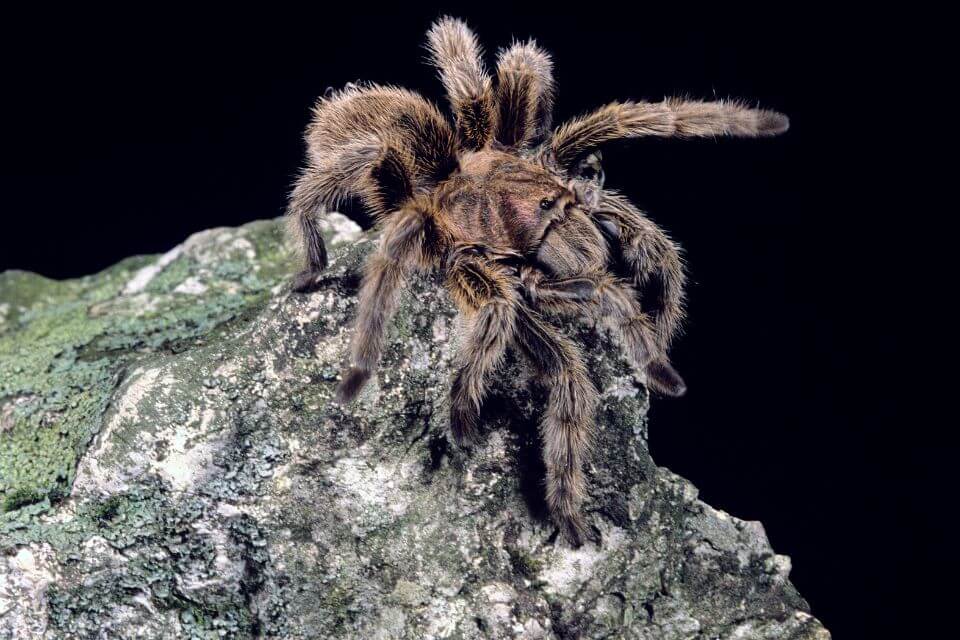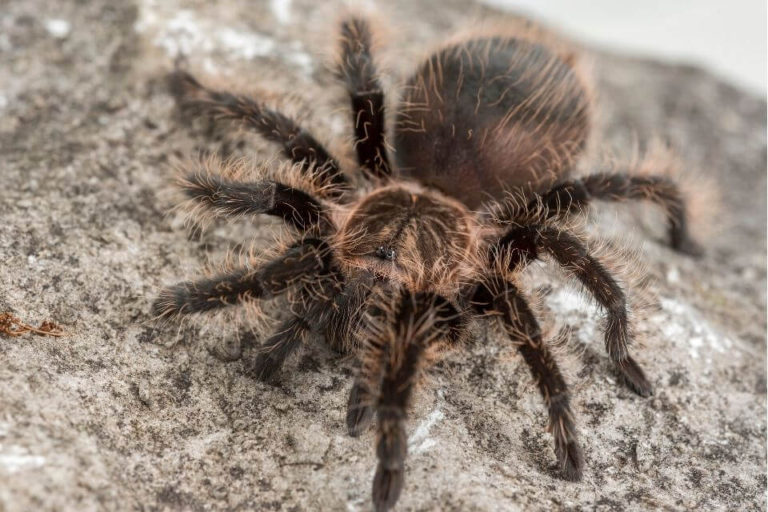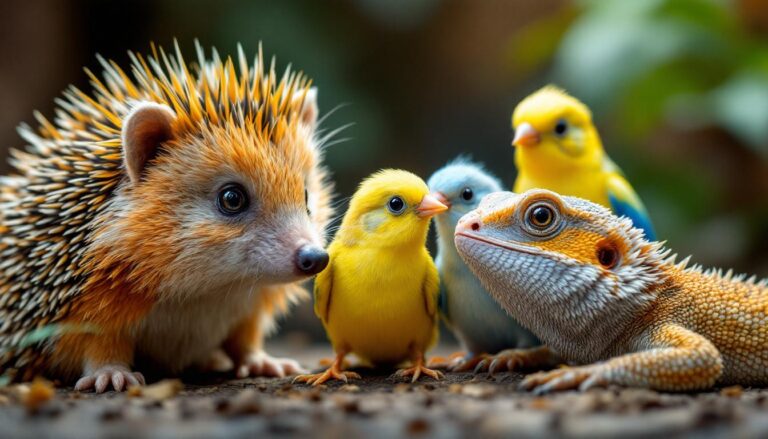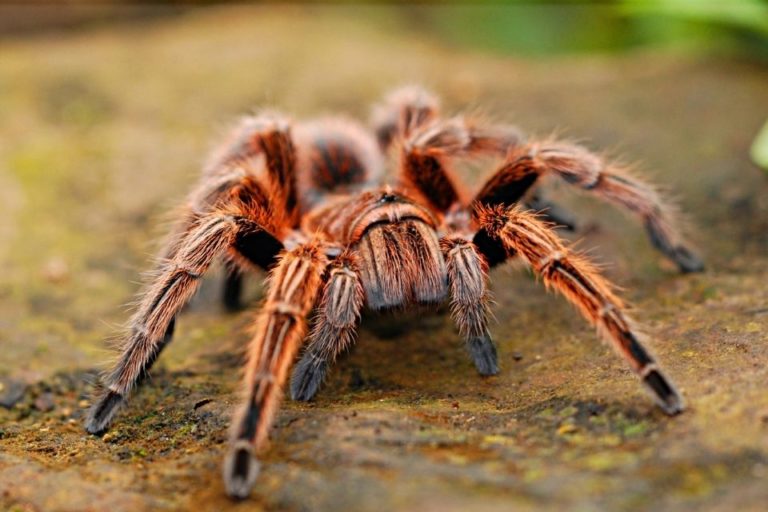Rose Hair Tarantula Care: Lifespan, Size, Food and Keeping

Rose Hair Tarantula (aka Chilean Rose Tarantula) is one of the most colorful giant spiders that you can keep as a pet in an enclosed tank.
You probably didn’t think you would have a tarantula as a pet, but you may have grown to like these little creatures after spending time with them in other places.
Now that you have your pet in your hand, you’re clueless about how to take care of it. Don’t worry. We’ll walk you through this guide so you’ll have everything you need to know to care for your tarantula.
Species Overview
The Rose Hair Tarantula is one of the most common tarantulas kept as pets. They are a docile species that is easy to care for and doesn’t require a lot of space.
Chilean Rose Tarantula can grow up to six inches in leg span but are typically around four inches when mature. They are light to dark brown with reddish hairs on their abdomen.
They make good pets for those interested in spiders but don’t want something too large or aggressive. Caring for this Tarantula, from selecting a healthy specimen to setting up its enclosure and providing the right food and water.
Rose Hair Tarantula Behavior and Temperament
You’re in luck. Since you already have this tarantula and you can’t take it back, you will be pleased to know that these tarantulas are safe. Chilean Rose Tarantula is not poisonous, and they are calm to a person’s touch.
These spiders are so calm that these spiders are also used as props in television and movies. However, they can react if you have an animal that scares them.
Also, if you are inappropriately handling these Chilean Rose Tarantulas, they may bite or release hairs from their body. If you inhale those hairs, it could do some damage to your lungs.
If your tarantula is about to bite, it will raise its two front legs and will show you its fangs. When approaching your tarantula, be sure to slowly walk up and reach your hand out.
Don’t try grabbing the tarantula because they will get startled. When your Chilean Rose Tarantula sees your hand out, they will come to you on their own.
Rose Hair Tarantula Lifespan
Female Rose Hair Tarantula lifespan is generally longer than male counterparts. Females live around 20 years, but males only live about five years. As long as these tarantulas stay in a cooler environment, they will live longer.
If you keep your tarantula in a heated room, they won’t live as long. Another reason why females live longer is they don’t eat as much food as the male Chilean Rose Tarantula do. The more a tarantula eats, the shorter its lifespan will be.
Rose Hair Tarantula Size
These aren’t large tarantulas, but they aren’t small either. These tarantulas are somewhere in between. Females tend to be larger than males but not by much.
The largest female tarantula has been reported to be only 5 inches, which is about 12 to 13 centimeters. Males are smaller, but they have longer legs than females do.
Male tarantulas are only about 3 and a half inches, which comes to about 9 centimeters. Since you already have your tarantula, you may notice that they are not as big as they appear to be in pictures.
Growth Rate
Just like humans and other animals, Rose Hair Tarantulas start as babies before they reach their adult size. They grow a little bit each year. They start small, and it will take them up to 4 years before these tarantulas reach adulthood.
Some people have mentioned they have noticed their Rose Hair Tarantula grow about 3/4’s of an inch in only a couple of years, and they will get a little bit bigger than that in the next couple of years.
If you want, you can take a tape measure and see how big your tarantula is. If it’s tiny, you know you have a baby. If it is 5 inches, you’ll know that you have a female tarantula.
Appearance and Colors
Some tarantulas are gray, but some are pink. It can also be a reddish-brown color. Some are dark brown. You may see some tarantulas that have all of these colors.
Their body may be gray, and their legs may be reddish-brown at the end with pink coloring starting at their legs. The back of the tarantulas may be dark brown. You will typically see rose hair tarantulas in all colors.

Some are different than others. While some Chilean Rose Tarantula has reddish hairs on their body, others have a body that’s tan with coppered color hairs.
As you’re reading this and looking at your tarantula, you may not notice, but they have eight eyes. Their eyes are small and not very strong.
Rose Hair Tarantula Care
In this section, you will learn how to care for your tarantula. There are lots of things you will need to know to make sure they are well taken care of. We’ll talk about how to set up their tank, temperature, decorations, and everything in between.
– Rose Hair Tarantula Tank Size
Their tank size is smaller than other animals that require a tank. You only need a 5 or 10 galloons enclosure. If you have a tarantula that is full-grown, you don’t need anything less than 10 gallons.
If you already have a tank for your tarantula and it’s bigger than that, then that’s okay but not necessary. Rose Hair Tarantulas don’t need as much space as other animals do to move around.
They’re happy with something small, but they don’t mind something larger. You might have to fill it up with decorations or toys, but we’ll get into that a little bit later.
– Rose Hair Tarantula Tank Setup
You only need one tank to house your tarantula. If you have another one, you might want to see if you can take it back. Their tank doesn’t need water since rose hair tarantulas are land animals.
You may want to fill it up with dirt or soil since they are usually in the dirt when they’re in the wild.
Substrate:
The substrate is something you put at the bottom of your tank creating a layer for the tarantula to walk in and go to the bathroom. As previously mentioned during the tank setup, you can grab some soil from your garden and put it in the tank.
It is required to heat for about 20 minutes in the oven at about 200 degrees Fahrenheit. To keep the tarantula from getting sick, it is required that you kill the bacteria before placing the tarantula in the tank.
If you don’t have a garden, you can purchase a substrate at your local pet store, such as coconut fiber. You would need to find a pet store that sells that, such as somewhere that sells exotic pets.
Temperature and Heating:
Be sure you don’t place your tank in a heated room or under a heater because you could kill it at a faster pace. You don’t want to do that. Tarantulas will get chilly so be sure you don’t put your pet in a cold area or under the vent.
If you keep your house unusually cold, you can purchase a heat mat for reptiles and put it on top of your substrate in your tank so they can get a little bit warmer.
Your tank should be in a room where the temperature is no more than 80 degrees Fahrenheit. 80 degrees may be pushing it a little bit so try to keep the room at least 75 degrees.
If it’s lower than that or at the borderline, then you can mist your tank by using bottled water so the humidity percentage can grow.
Lighting and Exposure:
Rose hair tarantulas don’t need any extra light if it’s already in a well-lighted room. It won’t hurt them if you put a light in their tank, but it’s not required.
If the room is dark, such as at night when you’re going to sleep, you may want to turn on a little night light for them since they’re active at night.
Water and Humidity:
We have already been over the humidity a little earlier on, but it’s best to include that 65 percent humidity is borderline. The humidity cannot be any lower than that. Even 65 percent is pushing it a little bit.
Now, let’s go over water. Just like everything else, the rose hair tarantulas need to drink as well. If you place a small water bowl that’s shallow enough for them to get to in their tank, you must put it where they can see it and get to it.
You can put it by the place they always seem to hang out in their tank.
Decorations:
Now comes the fun part. To help your tarantula get settled in its new environment, you can add decorations to its tank. Your Chilean Rose Tarantula would love a place to hide in so they can sleep.
You can add a small cave that’s big enough for your Chilean Rose Tarantula to get in and out of. You can also add plants and little rocks here and there.
Diet and Feeding
Feeding is an important thing to know. You must know what to feed them so they won’t go hungry and get sick. You can collect live crickets or other insects. The insects have to be small enough so they will fit in the tarantula’s stomach.
You can collect these from outside in your backyard or you can go to an exotic pet store. They might carry them. You can also purchase a small pinky mouse for them to eat.
Molting Rose Hair Tarantula
Molting means the tarantula is shedding its outer layer to make room for the tarantula to grow. If your tarantula is already an adult tarantula, it won’t go through a molting process.
If your tarantula is going through a molting process, it’s important not to touch them during that time. It may take 15 minutes for the process to be completed, or it may take 24 hours.
You will be able to see when your tarantula has gone through the process because it will leave its outer layer behind in the tank. Be sure you clean that out when you clean out the tank.
Common Health Problems
One health problem rose hair tarantulas face is dehydration. If you’re keeping your tarantula under cold temperatures and you’re not providing water for it to drink, then your tarantula will become dehydrated.
You’ll notice something’s off when you look at their stomach. Their stomach will look wrinkled. If you notice that it is wrinkled, fix it by changing the tarantula living environment.
Another health condition is dying. You’ll notice that they are so sick when it’s not moving or they’re really tired. If they’re really tired, then they will stay in their cave all day instead of being active in their tank.

Rose Hair Tarantula Breeding
If you have a male and female tarantula in your tank, more than likely they will start breeding. They have to be at the right age, and it has to be during the correct season.
The rose hair tarantula will start breeding at around 2 years old but no more than 3 years old. They start breeding twice a year, in September and October. It’s about six weeks for their gestation period.
When a female tarantula does lay an egg, there will be lots of them. Before you know it, you’ll see no more than a hundred tarantulas in the tank.
Pros and Cons When Keeping it as a Pet
One advantage is that these pets are low maintenance. All you have to do is give them fresh water and soil, and clean out their tanks. You also need to be sure you’re feeding them twice a week, but that’s it.
Another advantage is that they are friendly and only attack if they get scared. You get to keep these pets for a lot longer than you would keep other animals. As we mentioned earlier, a female tarantula can live for 20 years or more.
Another advantage is you can take it anywhere, and they can live in an apartment with you. You don’t have to worry about anyone asking you to remove it from the premises.
One of the disadvantages is when they bite, they are painful. Another disadvantage is that they are not cuddly pets, and they don’t like for you to hold them too often.
If you have never had a tarantula before, you may not want to purchase this pet because it can be scary.
Alternative Tarantula Species to Keep as a Pet
There are several alternatives if you are not happy with the Rose Hair Tarantula, but we’ll go over a few of them.
The Pink Toe Tarantula is one of the best alternative Tarantula breeds to think of. Pink Toe Tarantula is black but they have pink at the end of their legs.
Another type of tarantula is the Brazilian black tarantula. These tarantulas make great pets because they are gentle and run instead of attacking.
The Chaco Golden Knee tarantulas live longer and are bigger than the rose hair tarantulas because they can grow to about 8 inches.
Curly Hair Tarantula is also a great pet that has similar caring requirements as Rose Hair Tarantula.
How Much Does a Rose Hair Tarantula Cost?
A rose hair tarantula will cost you no more than 30 dollars, and it will cost at least 20 dollars. The price doesn’t stop there. You need to purchase the tank, which is about 20 dollars and you’ll need to purchase decorations.
You also need to purchase food and soil. When you add up the total costs, you can walk out of the pet store spending less than a hundred dollars.
Maintenance Expenses When Keeping This Tarantula
Maintenance expenses are very low. You may need to spend money purchasing products to clean the tank and replace it with fresh soil.
Plus, you will need to spend at least 5 dollars a month purchasing food for your tarantula. Your maintenance expenses can be as low as 30 dollars a month or even lower.
FAQs
– Are rose hair tarantulas friendly pets?
They are until they feel scared. If they feel frightened, then they will attack. As long as you don’t let any animals get too close to them and you are gentle with these creatures, then they won’t harm you.
– Are rose hair tarantulas venomous?
This tarantula does have venom, but it’s used for good, such as to digest prey. If it bites you, you will not be poisoned or require any hospitalizations unless you have an allergic reaction to the bite. In other words, a bite would be painful, but it won’t harm you.
-Are rose hair tarantulas good for beginners?
No, because it can be scary not knowing how to handle a pet like this. It’s best to start with other creatures, such as an iguana before you move on to a tarantula of this caliper.
-Can you handle Chilean Rose tarantulas by hand?
You can for a little bit. Don’t hold them for too long because they will feel uncomfortable and will bite. When they bite, it’s a warning sign letting you know they want to be put down.
These tarantulas like to be independent and move around on their own. You can pick them up to pet them but put them back down.
-Do rose hair tarantulas bite?
Yes but only if they feel attacked. If their handler is not calm, they will feel scared. They may feel like they’re in danger and will try to protect themselves.
-Do rose hair tarantulas hiss?
Yes but only if they are disturbed. They will make their hissing sound by rubbing their two front legs together. That’s your warning sign to leave them alone.
Final Thoughts
This may be a lot of information to take in, but you can always refer back to it later. This guide will help you understand and get to know your pet tarantula a little bit better.
Hopefully, all your questions have been answered, and you are more prepared than you were before you started reading this guide. By now, you should have all the information you need to know exactly what to do to take care of your new pet.




